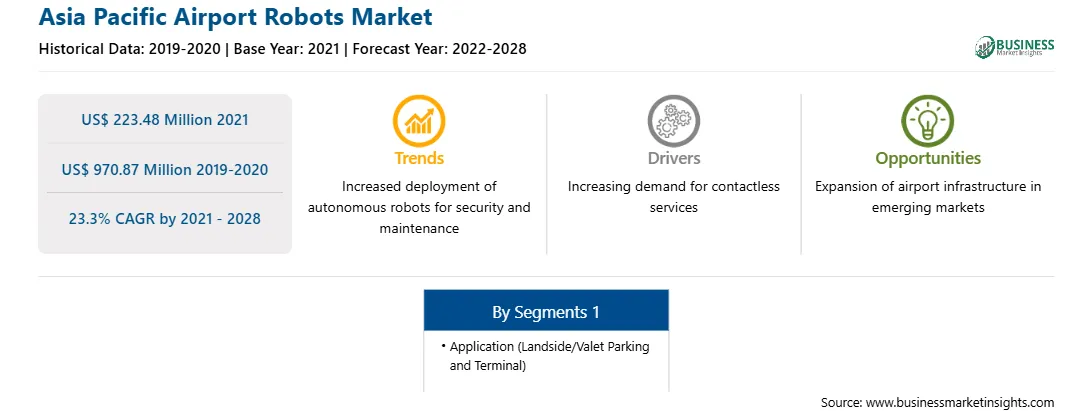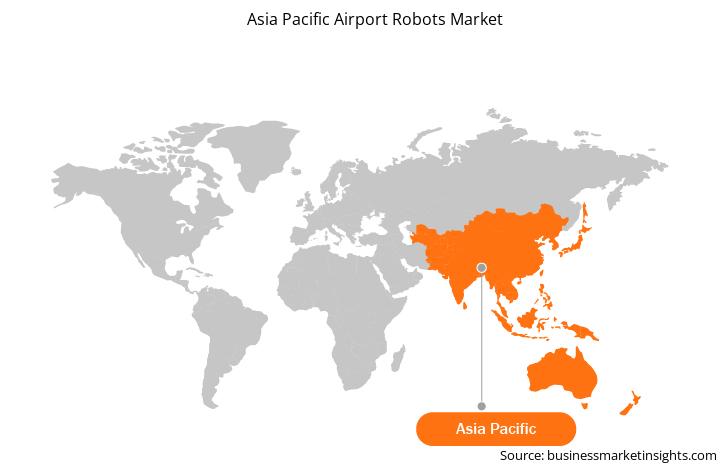The air passenger traffic in the region has increased significantly in recent years, welcoming numerous airport renovation proposals to improve passenger handling capabilities and operating efficiencies. In addition, surge in new airport construction projects, especially in countries such as China and India, is offering future growth opportunities to the airport robots market players. Moreover, advancements in automation technologies are likely to revolutionize the entire process flow architecture at airports. Artificial intelligence (AI), the Internet of Things (IoT), and predictive analysis are being used for modernizing various airport operations. Asian countries such as China, India, the Philippines, and Indonesia have invested heavily in new airports and infrastructure to cater to the growing passenger traffic through the expansion of existing airports or building of new ones. The infrastructure development activities are highlighting the need of smart ways to automate and control the services provided at airports. Moreover, the presence of airport robot manufacturers such as Softbank Robotics, LG Electronics, and Yujin Robot contributes to the market growth in the region. The key companies focus on investing in upgrading to new technologies. The COVID-19 pandemic has severely affected the growth airport robots market growth in APAC due to disruptions in supply chain and shutdown of airports due to travel bans. However, the social distancing measures and sanitary norms implemented at airports to decelerate the spread of the virus, thereby ensuring the safety of passengers travelling through the airports, is bolstering the demand for airport robots.
In case of COVID-19, APAC is highly affected specially India. The APAC constitutes the world’s two most populated countries that are also hubs for manufacturing – India and China. China virtually imposed strict lockdown and social isolation, which almost halted the manufacturing and production for several weeks. Moreover, the country also suspended the import as well as export of critical raw materials and components, which disrupted the global supply chains in early 2020. India also imposed a nationwide lockdown to keep a check on the growing COVID-19 cases across the country. As a result, lockdown and disruption of industrial activities across China and India contributed to the disruption of supply chain of various raw material and goods. However, these countries had to permit the manufacturing of a few essential goods. Travelling was restricted, and several huge airport expansion and development projects were halted for months. For instance, in India, expansion of Kolkata Airport as well as Bangalore Airport was halted, owing to the pandemic that was at peak in mid-2020. With such halts of major projects, demand for new airport robots got skewed as well, impacting the India airport robots market. Similar trend was visible in other parts of the region. However, Indira Gandhi airport in India saw deployment of new robots. Also, airports in Singapore observed the increase in number of robots to help customers increase. Therefore, the impact of COVID-19 pandemic on Asia Pacific airport robots market was significant.

Strategic insights for the Asia Pacific Airport Robots provides data-driven analysis of the industry landscape, including current trends, key players, and regional nuances. These insights offer actionable recommendations, enabling readers to differentiate themselves from competitors by identifying untapped segments or developing unique value propositions. Leveraging data analytics, these insights help industry players anticipate the market shifts, whether investors, manufacturers, or other stakeholders. A future-oriented perspective is essential, helping stakeholders anticipate market shifts and position themselves for long-term success in this dynamic region. Ultimately, effective strategic insights empower readers to make informed decisions that drive profitability and achieve their business objectives within the market.

| Report Attribute | Details |
|---|---|
| Market size in 2021 | US$ 223.48 Million |
| Market Size by 2028 | US$ 970.87 Million |
| Global CAGR (2021 - 2028) | 23.3% |
| Historical Data | 2019-2020 |
| Forecast period | 2022-2028 |
| Segments Covered |
By Application
|
| Regions and Countries Covered | Asia-Pacific
|
| Market leaders and key company profiles |
The geographic scope of the Asia Pacific Airport Robots refers to the specific areas in which a business operates and competes. Understanding local distinctions, such as diverse consumer preferences (e.g., demand for specific plug types or battery backup durations), varying economic conditions, and regulatory environments, is crucial for tailoring strategies to specific markets. Businesses can expand their reach by identifying underserved areas or adapting their offerings to meet local demands. A clear market focus allows for more effective resource allocation, targeted marketing campaigns, and better positioning against local competitors, ultimately driving growth in those targeted areas.

The APAC airport robots market is expected to grow from US$ 223.48 million in 2021 to US$ 970.87 million by 2028; it is estimated to grow at a CAGR of 23.3% from 2021 to 2028. With the rise in real and perceived threats to the national security, continuous efforts are being taken to come up with innovative active interrogation approaches to identify these threats. The most instant perceived threats and their essential materials comprise, conventional explosives, weapons, chemical agents, and contraband. With an intent to prevent the uncertain events, authorities across the region are actively focusing on the deployment of advanced systems, including robots, to strengthen security at airports. The robots used for security application at airports are integrated with features such as facial recognition systems, sensors, and cameras to measure pulse rate remotely, which allows them to detect suspicious persons, currencies, weapons, and explosives, abandoned objects, and other illicit material without disturbing the operations or flow of passenger at airports. Further, the governments of various countries are investing in the development of their transport infrastructure, including building of new airports. For instance, the Chinese government plans to construct additional 215 airports by 2035. Also, by 2024, the Indian government plans to build 100 new airports across the country. Thus, significant contracts between airports and market players as well as growing construction activities of new airports are propelling the growth of APAC airport robots market.
In terms of application, the terminal segment accounted for the largest share of the APAC airport robots market in 2020. In terms of terminal, the airport security and cleaning segment held a larger market share of the APAC airport robots market in 2020.
A few major primary and secondary sources referred to for preparing this report on the APAC airport robots market are company websites, annual reports, financial reports, national government documents, and statistical database, among others. Major companies listed in the report are ABB Ltd.; Avidbots Corp.; CYBERDYNE INC.; ECA Group; LG Electronics; SITA; SoftBank Robotics; and YUJIN ROBOT Co., Ltd.
The Asia Pacific Airport Robots Market is valued at US$ 223.48 Million in 2021, it is projected to reach US$ 970.87 Million by 2028.
As per our report Asia Pacific Airport Robots Market, the market size is valued at US$ 223.48 Million in 2021, projecting it to reach US$ 970.87 Million by 2028. This translates to a CAGR of approximately 23.3% during the forecast period.
The Asia Pacific Airport Robots Market report typically cover these key segments-
The historic period, base year, and forecast period can vary slightly depending on the specific market research report. However, for the Asia Pacific Airport Robots Market report:
The Asia Pacific Airport Robots Market is populated by several key players, each contributing to its growth and innovation. Some of the major players include:
The Asia Pacific Airport Robots Market report is valuable for diverse stakeholders, including:
Essentially, anyone involved in or considering involvement in the Asia Pacific Airport Robots Market value chain can benefit from the information contained in a comprehensive market report.